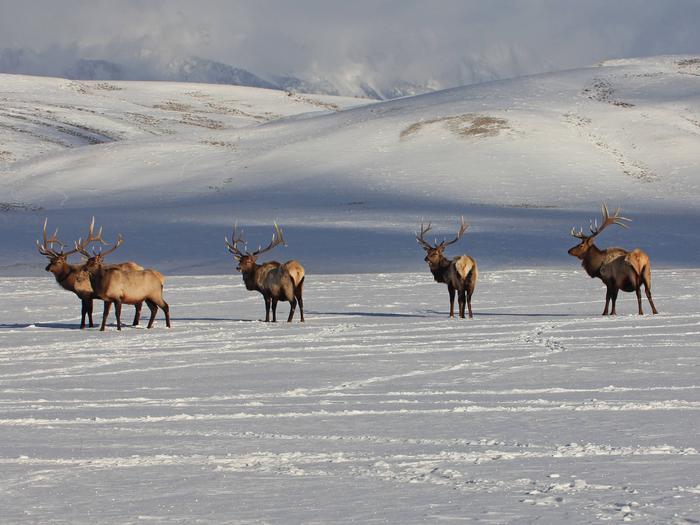National Elk Refuge
Fish and Wildlife Service, Wyoming.
Wildlife conservation is at the heart of what makes the National Elk Refuge unique and unparalleled in the Greater Yellowstone Ecosystem. Conservation of native species and their habitats is the core management mission of the Refuge.
The Refuge protects critically important habitat for numerous iconic species, including elk, bison, wolves, trumpeter swans, bald eagles, bighorn sheep, and cutthroat trout. The landscape of the Refuge is primarily glacial outwash plain and rolling hills with a narrow, winding river. The Refuge is surrounded by the rugged peaks of the Teton and Gros Ventre Mountain Ranges.
The Refuge was established by various Acts of Congress, executive orders, and other documents to provide, preserve, restore, and manage lands for wintering elk, birds, and other big game animals. The main Act of Congress on August 10, 1912 set aside lands “for the establishment of a winter game (elk) reserve in the State of Wyoming, lying south of the Yellowstone Park . . .”
The National Elk Refuge, along with the lands and waters of the Greater Yellowstone Ecosystem have been home to Indigenous peoples since time immemorial. Numerous Tribes consider the GYE a part of their ancestral homelands. This includes, but is not limited to, Apsáalooke/Crow, Arapaho, Cheyenne and Ute Nations, Bannock, Aaniiih/Gros Ventre, Ksanka/Kootenai, Lakota, Weyíiletpuu/Cayuse, Umatilla, Walla Walla, Lemhi, Little Shell Chippewa, Nakoda/Assiniboine, Nez Perce, Niitsitapi/Blackfeet, Ql̓ispe/Upper Pend d’Oreille, and Séliš/Bitterroot Salish.
The Refuge is nationally renowned as a place to observe wintering elk, bighorn sheep, trumpeter swans, and bald eagles. Most visitors to the Refuge during the winter months take a horse-drawn sleigh to see the elk, drive the Refuge Road to observe wildlife, or stop by the visitor center for educational programming and information.
The summer brings an influx of visitors to the area. The Refuge is the gateway from town of Jackson, WY to Grand Teton National Park and the Bridger-Teton National Forest. Cycling, walking, and birding along the Multi-use Pathway are popular summer activities. Visiting the Historic Miller Ranch interpretive site and the visitor center provide great opportunities to get oriented to the area. Many visitors drive the Refuge Road at sunset to observe wildlife, watch the sun crest behind the Tetons, or access camping in the nearby National Forest camping zones.
Elk are typically visible on the Refuge from mid-December through early April. In late spring, elk begin migrating off of the Refuge towards their summer ranges. The majority of elk will follow the receding snow line up to higher elevations in Grand Teton National Park and in the Teton Wilderness in the Bridger Teton National Forest. From October through December, deepening snow push the elk down from their higher summer ranges to seek food and shelter at lower elevations in Jackson Hole.
Nearby Activities
- Biking
- Educational Programs
- Fishing
- Hiking
- Historic & Cultural Site
- Hunting
- Interpretive Programs
- Photography
- Visitor Center
- Wildlife Viewing
Directions
From the town square of Jackson, drive east on Broadway Avenue until you reach a sign that reads "National Elk Refuge." From there, you are on the Refuge Road.
- From December 1 - April 30, the Refuge Road is open for 3.5 miles for public access. Visitors are reminded to obey all posted wildlife closure signs and remain on the road or in designated pull-outs at all times.
- From May 1- November 30, the Refuge Road is open to the National Forest access roads, Flat Creek Road and Curtis Canyon Road. Road maintenance is minimal after the Twin Creek subdivision. Visitors are reminded to obey all posted wildlife closure signs and remain on the road, in designated pull-outs, or on Forest Access trails at all times.

